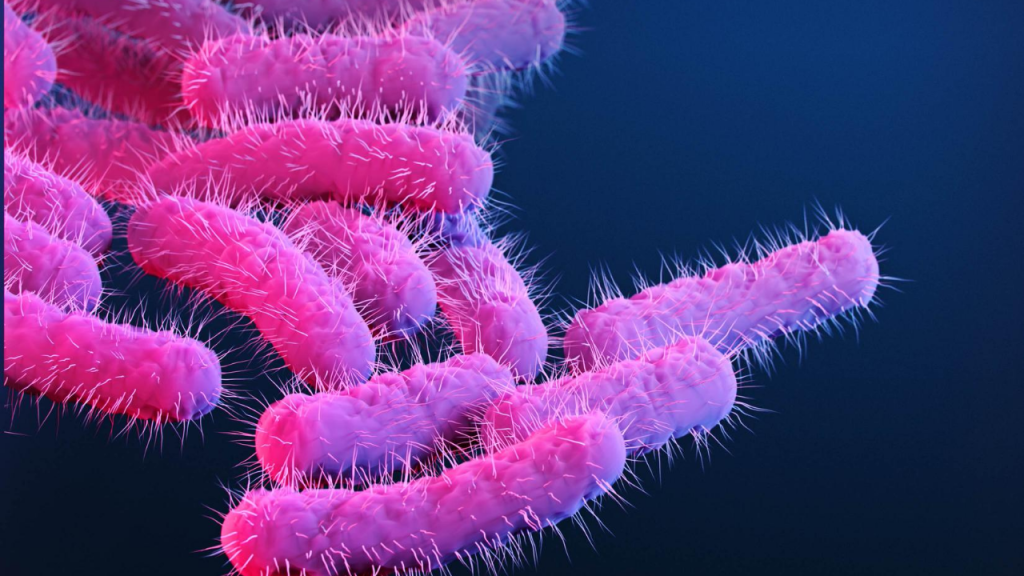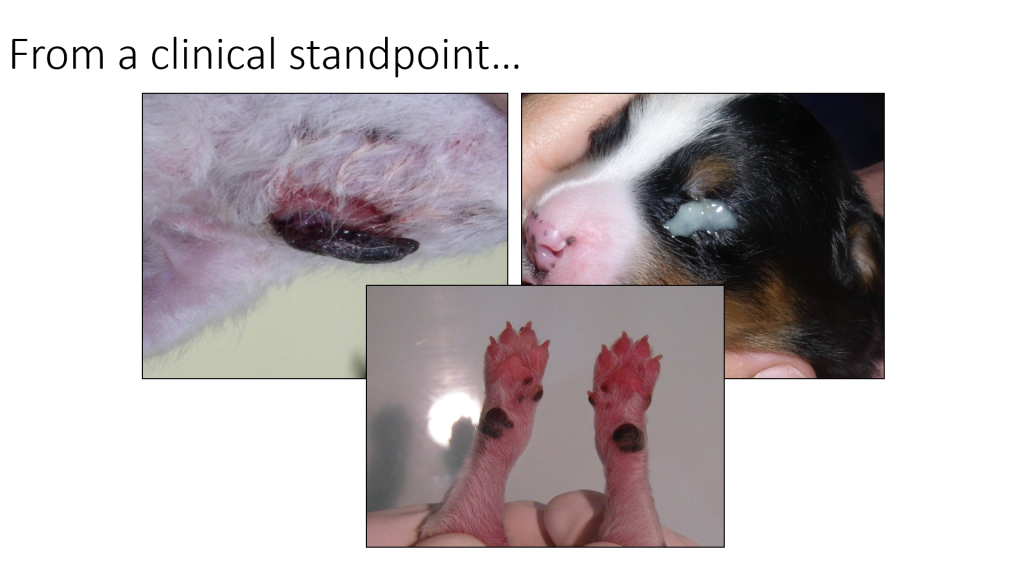🇫🇷Lire en Français | 🇪🇸Leer en Español | 🇧🇷Leia em português
A colleague of mine recently whatsapped me an interesting picture.

I think we can agree : this is definitely some “weird-looking” newborn kitten.
It indeed looks like there is “something” bulging from behind its eyelids…
No doubt there is something wrong here !
When I saw the picture, one word immediately came to mind.
A disorder we call “ophtalmia”.
Disclaimer : I am not sure this picture I received was indeed a case of ophtalmia – one can hardly make a diagnosis just based on a picture as you can imagine, you can just take a wild guess. It could have been something totally different, like a congenital ocular abnormality or who knows what else. That being said – ophtalmia is something that could be considered here… and this definitely leads to an interesting discussion 🙂 Keep reading to find out what I mean !
Ophtalmia is an infection of the eye.
I have seen it a few times in newborn puppies in the past.
The infection leads to production of pus ; and because at this young age, the eyes are not yet opened, the pus basically accumulates behind the eyelids.
Leading to this “bulging aspect” you can observe on the picture.

The infection is typically of bacterial origin – although when I saw this particular picture I had a look at the literature and found that some ocular abnormalities in kittens could be related to FeLV as well… something good to keep in the corner of our mind as FeLV is described as causing neonatal mortality in the feline species.
What do we do when we face those situations in veterinary medicine ?
It will be very similar to what we would do for an abcess : we need to get the pus out of there.
And because this happens in newborns – which immature immune system can easily be overwhelmed by any bacterial infection – we need to act as soon as possible.
Here, it would therefore mean opening the eyelid by doing a small incision.
Spoiler alert : NEVER EVER attempt to do that yourself. Always consult with a veterinarian.
Opening the eyelid will help evacuate the pus… and as written earlier, then we would treat this like we would treat a typical abscess.
What I find interesting about those cases is actually HOW they happen.
Because there are some good lessons to be remembered here for every dog & cat breeder.
The first question we need to ask ourselves : where do those bacteria come from ?
And actually, there are mainly 2 origins to consider.
They can come from the mother… or they can come from the environment the mother and newborns are in.
Just knowing that already gives you those 2 parameters you need to pay extra-attention to, in order to prevent neonatal bacterial infections.
Having those two under the control is indeed the best thing you can do in terms of prevention.
Let’s focus on the mother first : how could she “transfer” a high amount of bacteria to her offsprings after birth ?
#1 By licking them
This can become a potential problem if there is an “abnormally high” amount of germs in the mother’s oral cavity….
Which is why in breeding bitches and queens, you should always focus on their oral health.
Indeed, over time, dental plaque (=basically, bacteria) accumulates on our animals’ teeth. And if nothing is done, this plaque progressively turns into tartar (= basically, “very high amount of mineralized bacteria” ==> definitely NOT a good thing…).
When the mother licks the newborns, to groom them and/or stimulate miction/defecation, well, if oral health were to be a concern, a high quantity of bacteria can then be transferred to the newborns… potentially leading to bacterial infections like described earlier.
Keep in mind the same is true when the mother cuts the umbilical cord, right after birth (but more on this later).
Obviously, to prevent this from happening, the common oral health recommendations (teeth brushing, feeding a diet that help optimize dental health, regular dental health assessment from your veterinarian) are of the utmost importance.
If you breed dogs and cats, this is definitely something you must pay extra-attention to in the dams before breeding them !
#2 By nursing them
The other way puppies can “receive” a high amount of bacteria from their mother is when they nurse.
Mastitis (=inflammation of the mammary gland) is typically of bacterial origin and if puppies/kittens ingest contaminated milk, well, as described earlier, their immune system can be overwhelmed.
Mastitis can often happen right after birth.
The recommendation I give to all breeders : after parturition, assess DAILY all mammary glands.
– Start by palpating them : they should not be warm/hard/painful (which are typical signs of inflammation).
– Then check the milk’s colour : in the first 24h after birth, it is often yellowish (which is actually the colour of the colostrum) but after that, it should be white ; any other colour (brown, red…) is NOT acceptable ;
If you were to detect a problem, immediately consult with your attending veterinarian. And meanwhile, switch the newborns to a milk replacer (BTW, that’s one of the reasons why you ALWAYS need to have a dedicated milk replacer on hand when you have newborn puppies/kittens !).
What about the environment ?
The environment the newborn puppies and kittens are in is definitely something you must not overlook, as it can act as a “germ reservoir” for those neonatal bacterial infections.
If there were to be a “higher than normal” amount of germs in their environment :
– newborn puppies/kittens crawling around can indeed be in direct contact with those…
– the bacteria can actually also reach the mother’s mammary gland and lead to mastitis as well…
And those are the most common clinical expressions we will see in puppies/kittens.

As you can see, ophtalmia is one of them.
Here again, there are a couple of things you can do in terms of prevention.
#1 Take good care of the umbilical stump
Umphalo-phlebitis (=“infection of the umbilical cord”) is a very common cause of morbidity in newborns in all mammals.
This is indeed a blood vessel that directly connects inside the abdomen ; it is a contamination route germs can use. And remember what I wrote about the importance of the mother’s oral health : if she cuts the umbilical cord and oral health was a concern, there is a risk for bacterial infection here as well !
Therefore, whether the mother cut the umbilical cord of the newborn or whether you did it yourself, it is recommended to disinfect its terminal end 2-3 times a day until it falls down (any kind of disinfectant will do here – like chlorexhidine or diluted iodine for instance).
This very simple measure is actually of great importance as it allows you to prevent one of the most common cause of neonatal bacterial infection !
#2 Keep the environment as clean as possible
It goes back to what we mention in several blogs : keep the nest as clean as possible (and when needed don’t hesitate to disinfect). This blog HERE will tell you all about those two essential concepts in catteries and kennels.
An important thing to focus on is the linens you are using for the newborns : if you use towels for instance, make sure you change them daily (so make sure you have several sets); and make sure those are cleaned and disinfected (good news : your washing machine here will be your friend – just wash at high temperature).
Those are also tiny details you must pay attention on a daily basis. But they are crucial to prevent neonatal bacterial infections in puppies and kittens.
#3 Bonus Tip : make sure the newborns drank the colostrum
I wrote a lot about colostrum in previous blogs (see the links below) but I just want to reiterate how important it is to ensure colostrum intake in newborns.
Newborn Puppy | Energy | Immunity
No Colostrum : What About Serum ?
Colostrum 101 : What You MUST Know if You Breed Dogs & Cats
This will help support their immune function before they are able to build their own; and recent studies have shown that lack of colostrum intake can actually have an impact on neonatal survival.
As soon as the newborns are born, put them on the mammary glands. And if you are lucky enough to have access to a milk replacer supplemented in immunoglobulins, don’t hesitate to use it as a back-up just in case !
Neonatal bacterial infection are always a threat, and you see, there are a few things you can already do to prevent them.
I think it was a good think this picture made me think of ophtalmia.
It lead me to write down those little pieces of advice I’d give to any breeder who want to prevent neonatal bacterial infection in newborns.
If this is not something you already do, I hope this is something you guys will consider implementing in your catteries and kennels !
Interested to learn more about canine neonatology? Download my free ebook on the topic HERE!


One of the most common challenge we encounter in breeding kennels is NEONATAL MORTALITY.
It can be very frustrating… even heart-breaking.
Good news though : you can do something about it !
We now have more knowledge than ever in this discipline.
In recent years, new research brought us a much better understanding of what can be done to optimize the health of newborn puppies.
By taking this course, this is what you will learn indeed !

Thank you Dr Fontaine.
On Wed, 12 Aug 2020 at 13:57, DR. EMMANUEL FONTAINE wrote:
> dremmanuelfontaine posted: ” A colleague of mine recently whatsapped me an > interesting picture. Courtesy of Dr Luis Meza I think we can agree : this > is definitely some “weird-looking” newborn kitten. It indeed looks like > there is “something” bulging from behind its eyelid” >
LikeLike